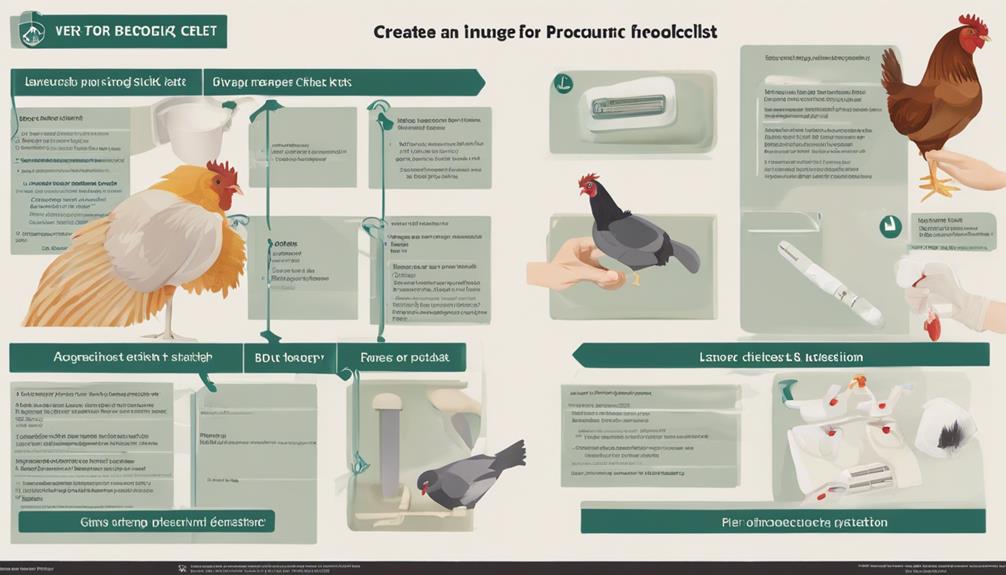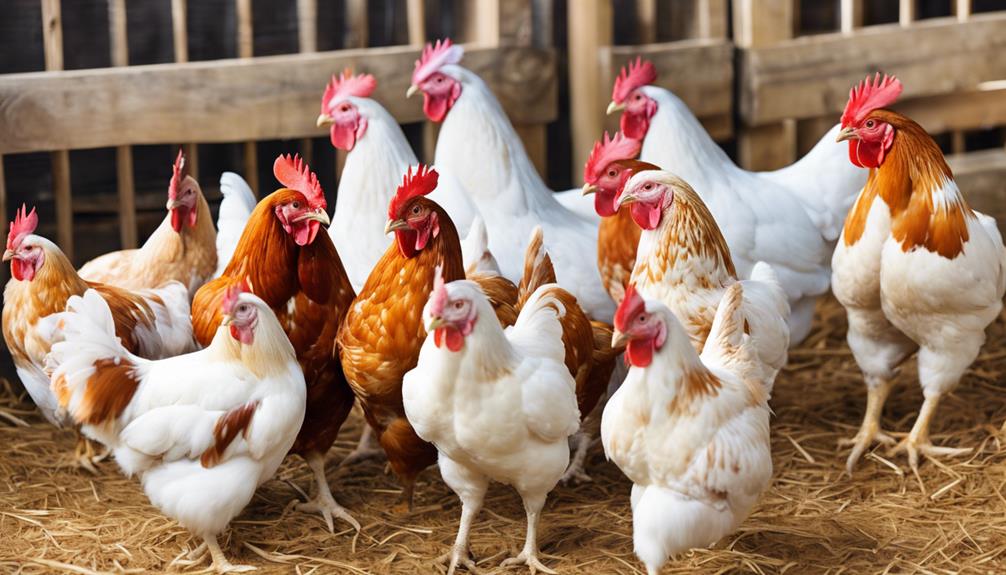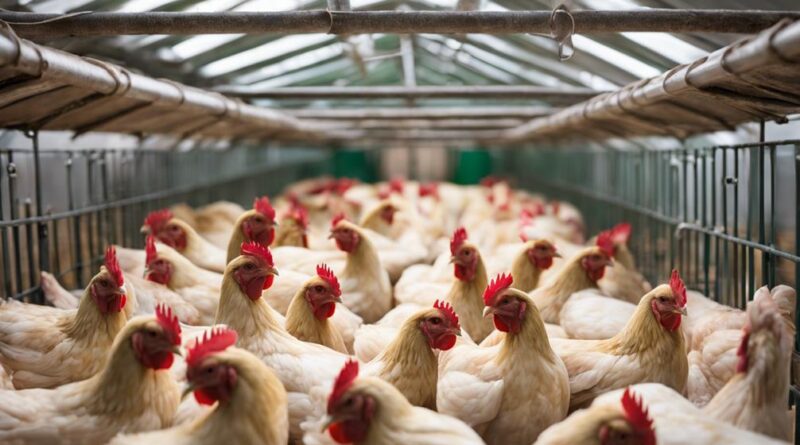Top 10 Best Practices for Layer Chicken Production"
To optimize your layer chicken production, prioritize proper housing with ventilation and temperature control. Manage feed quality and storage for a balanced diet and monitor water intake for health. Conduct regular health checks, follow a vaccination program, and implement biosecurity measures. Ensure optimal lighting and practice eco-friendly waste management. Focus on strategic breeding for diverse genetics and maintain detailed records for informed decisions. Embracing these best practices will elevate the health, welfare, and performance of your flock, setting the foundation for successful layer chicken production.
Proper Housing Requirements
For efficient layer chicken production, ensure the housing meets specific requirements to promote optimal health and egg laying performance. The ventilation system is crucial in maintaining good air quality and reducing the risk of respiratory diseases among the chickens. Proper ventilation helps remove excess moisture, heat, dust, and harmful gases from the chicken house. It's essential to have a well-designed ventilation system that can provide adequate air exchange without causing drafts, especially during colder months when maintaining the right temperature is vital.
Temperature control is another critical aspect of proper housing for layer chickens. Maintaining the ideal temperature range is essential for the chickens' comfort and productivity. During the growing and laying phases, fluctuations in temperature can impact feed consumption, egg production, and overall health. To ensure consistent temperature levels, consider using heaters, fans, or evaporative cooling systems based on the climate of your region. Monitoring tools such as thermometers should be strategically placed throughout the housing facility to keep track of temperature variations accurately.
Quality Feed Management
To optimize the health and productivity of your layer chickens, meticulous attention to quality feed management is paramount. Proper feed storage is essential to maintain the nutritional value of the feed and prevent contamination. Store feed in a cool, dry place away from direct sunlight to preserve its freshness and prevent mold growth. Regularly inspect the storage area for signs of pests or moisture that could compromise the feed quality.
In addition to proper storage, feed formulation plays a crucial role in ensuring your layer chickens receive a balanced diet. Work closely with a poultry nutritionist to develop a feed formulation that meets the specific nutritional requirements of your chickens at each stage of production. The formulation should take into account factors such as age, breed, and egg production levels to optimize performance.
Regularly monitor the quality of the feed by checking for signs of spoilage, such as unusual odors or discoloration. Conduct regular feed analysis to ensure that the feed meets the nutritional requirements of your layer chickens. Adjust the feed formulation as needed based on the analysis results to maintain optimal health and productivity.
Adequate Water Supply
Maintain a consistent and clean water supply for your layer chickens to support optimal health and productivity. Water quality is crucial for the well-being of your flock. Ensure that the water provided is free from contaminants, such as bacteria, algae, or excess minerals, which can negatively impact the health of your chickens. Regularly monitor the quality of the water source and clean waterers to prevent the buildup of harmful substances.
Understanding the consumption patterns of your layer chickens is essential for determining adequate water supply. Layers have specific water requirements that vary depending on factors such as age, ambient temperature, and diet. On average, a laying hen consumes between 0.2 to 0.4 liters of water per day. During hot weather or high egg production periods, water intake may increase significantly. It's crucial to adjust the water supply accordingly to meet the birds' needs.
Proper hydration is essential for egg production, digestion, and overall health. Inadequate water intake can lead to decreased egg production, poor egg quality, and health issues. Ensure that water is accessible to all birds throughout the day, especially during peak consumption times. By maintaining a clean water supply and understanding your layer chickens' consumption patterns, you can promote optimal health and productivity in your flock.
Regular Health Monitoring
Implement a systematic approach to monitor the health of your layer chickens regularly to ensure early detection of any potential issues. Disease prevention is a crucial aspect of maintaining a productive flock. Regular health monitoring involves observing the behavior and physical condition of your chickens daily. Look out for signs of illness such as decreased egg production, coughing, sneezing, or abnormal feces. By detecting these symptoms early, you can take necessary steps to prevent the spread of diseases within your flock.
In addition to visual monitoring, periodic health checks by a veterinarian are highly recommended. These checks should include thorough physical examinations, fecal tests for parasites, and blood tests to assess overall health. Implementing a vaccination program based on your region's prevalent diseases can significantly reduce the risk of illness among your chickens.
Nutrition plays a vital role in maintaining the health of your layer chickens. Ensure that your flock receives a balanced diet rich in essential nutrients. Regularly assess the quality of feed and consider supplementation if necessary to meet the specific nutritional requirements of laying hens. Proper nutrition strengthens the immune system, making chickens more resilient to diseases.
Optimal Lighting Conditions
Regular health monitoring for your layer chickens is a fundamental practice that can lead to improved flock health and productivity. When considering optimal lighting conditions, it's important to understand the impact light has on the behavior and performance of your chickens. Light intensity and duration play crucial roles in the overall well-being of your birds. Providing the appropriate light intensity levels and ensuring proper duration of lighting periods can significantly influence egg production, feed consumption, and overall bird activity.
Light color and spectrum are equally important factors to consider. Chickens are sensitive to different light colors, with red light being known to have a calming effect and promote natural behaviors like roosting and nesting. On the other hand, blue light can increase activity levels and stimulate egg production. Understanding the specific requirements of your flock and adjusting the light color accordingly can positively impact their performance.
To optimize the lighting conditions for your layer chickens, it's recommended to provide a consistent lighting schedule with gradual changes in intensity throughout the day. This mimics natural lighting patterns and helps maintain the birds' circadian rhythms. Moreover, ensuring a balance between light and dark periods is essential for promoting rest and preventing stress. By carefully managing light intensity, duration, color, and spectrum, you can create an environment that supports the health and productivity of your layer chickens.
Effective Waste Management
To effectively manage waste in your layer chicken production system, proper disposal practices must be implemented to ensure the health and hygiene of your flock. Waste disposal efficiency is crucial for maintaining a clean environment and preventing the spread of diseases among your chickens. Efficient waste disposal involves regular removal of manure, soiled bedding, and any other waste materials from the coop and surrounding areas. This not only reduces odor and flies but also minimizes the risk of contamination.
Recycling waste can also lead to significant cost savings. Consider composting manure and bedding materials to create organic fertilizer for your crops or landscaping. This practice not only reduces waste but also provides a sustainable solution for improving soil quality. Additionally, you can explore partnerships with local farmers or waste management facilities to recycle chicken waste into biogas or other useful byproducts.
It's essential to be mindful of the environmental impact of waste management practices. Improper disposal methods can lead to pollution of water sources and soil degradation. By implementing efficient waste management strategies, you not only protect the health of your flock but also contribute to a cleaner and healthier environment for future generations. Remember, effective waste management is a responsibility that benefits both your business and the surrounding ecosystem.
Biosecurity Measures

Maintaining strict biosecurity measures is paramount in safeguarding your layer chicken flock against potential disease outbreaks and ensuring overall health and productivity. Disease prevention starts with implementing robust quarantine procedures for all new birds entering your facility. Isolating and observing new additions for at least 30 days can help prevent the introduction of pathogens to your existing flock.
Additionally, controlling pathogens within your farm requires effective disinfection techniques. Regularly clean and disinfect all equipment, tools, and surfaces that come into contact with your chickens. Use appropriate disinfectants and follow recommended dilution rates to ensure maximum effectiveness.
Establishing designated entry points and footbaths can help minimize the risk of outside contaminants entering your poultry area. Visitors should follow strict protocols, including changing into farm-specific clothing and footwear before entering the premises. Implementing a rodent and pest control program is crucial as these animals can carry diseases harmful to your chickens. Regularly inspect and maintain fences, walls, and roofs to prevent unauthorized entry.
Maintaining a closed-loop system for feed and water sources reduces the risk of contamination. Store feed in secure containers to prevent access by wild birds and rodents. Regularly test water quality and ensure proper sanitation to avoid waterborne diseases. By diligently following these biosecurity measures, you can significantly reduce the likelihood of disease outbreaks and promote a healthy environment for your layer chicken flock.
Routine Vaccination Schedule
Implement a structured vaccination program to safeguard the health and productivity of your layer chicken flock against common diseases. Vaccination protocols are crucial in preventing the spread of infectious diseases among your chickens. Here are some key points to consider when establishing a routine vaccination schedule:
- Consultation with a Veterinarian: Before initiating any vaccination program, consult with a poultry veterinarian to determine the most appropriate vaccines for your specific flock and geographical location.
- Primary Vaccines: Administer primary vaccines to chicks at a young age to provide immunity against common diseases such as Marek's disease, Newcastle disease, and infectious bronchitis.
- Booster Shots: Schedule booster vaccinations at regular intervals to ensure continuous protection against prevalent diseases. Booster shots are essential to enhance and prolong the immunity acquired from the primary vaccines.
- Record Keeping: Maintain detailed records of all vaccinations administered to individual birds or batches. Proper documentation helps track the vaccination history of each chicken, enabling timely follow-up vaccinations and adherence to vaccination protocols.
Adhering to a well-structured vaccination program is fundamental in disease prevention within your layer chicken flock. By implementing these vaccination best practices, you can significantly reduce the risk of disease outbreaks and promote the overall health and welfare of your chickens.
Strategic Breeding Practices

When considering strategic breeding practices for your layer chicken flock, it's essential to focus on genetic diversity and desired traits to enhance overall productivity and health. Genetic selection plays a crucial role in developing a robust and high-performing flock. By carefully choosing breeding stock with desirable characteristics such as high egg production, disease resistance, and strong eggshell quality, you can improve the genetic makeup of your flock over generations.
Breeding techniques are vital in achieving the desired genetic improvements. Methods such as selective breeding, where only birds with the best traits are chosen for reproduction, can help concentrate favorable genes in the flock. Inbreeding should be avoided as it can lead to genetic abnormalities and decreased productivity. Instead, outcrossing with unrelated birds can introduce new genetic material and increase genetic diversity, which is essential for the long-term health and productivity of the flock.
It is also important to have a clear breeding goal in mind. Whether you aim to increase egg production, improve egg quality, or enhance disease resistance, having a specific objective will guide your breeding decisions. Regularly evaluating the performance of individual birds and tracking their lineage through proper record-keeping will help you make informed breeding choices and monitor the progress towards your breeding goals.
Record Keeping and Analysis
To optimize the genetic progress of your layer chicken flock, meticulous record-keeping and thorough analysis of breeding data play a pivotal role in guiding informed decisions for future breeding selections. Proper data organization and trend analysis are essential components for effective performance evaluation and decision making in your layer chicken production.
Here are four key points to consider:
- Data Collection: Start by establishing a comprehensive system for collecting data on individual chickens, including traits like egg production, hatch rates, and health records. This data forms the foundation for informed decision-making.
- Data Organization: Utilize software or spreadsheets to organize your data systematically. Categorize information by age, lineage, and specific traits to facilitate easy retrieval and analysis.
- Trend Analysis: Regularly analyze trends within your data to identify patterns related to productivity and health. This analysis can help you make proactive decisions to enhance overall flock performance.
- Decision Making: Based on the insights gained from data analysis, make informed decisions regarding breeding selections, culling strategies, and overall flock management. Data-driven decisions are key to optimizing the genetic potential of your layer chicken flock.
Frequently Asked Questions
How Can I Prevent Cannibalism Among Layer Chickens?
To prevent cannibalism among layer chickens, it is essential to monitor flock dynamics closely. Ensure there is sufficient space, feed, and water availability to reduce aggression. Trim beaks to minimize injurious pecking, and provide enrichment activities like pecking blocks or hanging vegetables. Promptly separate any aggressive birds, and implement proper lighting and ventilation in the coop. Regularly inspect birds for signs of stress or injury. Maintaining a calm and stress-free environment is crucial in preventing cannibalistic behavior among your layer chickens.
It is important to consider all these factors to ensure the well-being of your flock and prevent any harmful behaviors from developing.
What Are the Best Practices for Dust Bathing Areas?
To create optimal dust bathing areas for your layer chickens, focus on dust prevention and bathing techniques. Ensure the soil composition is suitable by using a mixture of sand, diatomaceous earth, and wood ash.
Provide ample space for your chickens to spread out and dust bathe comfortably. Regularly maintain and replenish the area to keep it clean and inviting.
Following these practices will help promote healthy behavior and overall well-being in your flock.
Is It Necessary to Provide Enrichment Activities for Layers?
Enrichment activities for layers are necessary to provide environmental enrichment and promote behavioral stimulation. These activities offer benefits such as reducing stress, preventing boredom, and encouraging natural behaviors.
Implementing a variety of enrichment options like perches, hanging treats, and dust bathing areas can enhance the overall well-being of your birds. By incorporating these activities into their environment, you can ensure that your layers remain healthy and content.
How Do I Manage Aggressive Behavior in My Flock?
To manage aggressive behavior in your flock, focus on behavior modification techniques. Understanding flock dynamics is key. Implement strategies like providing ample space, ensuring a balanced diet, and reducing stressors.
Separate aggressive birds if needed and monitor interactions closely. Utilize positive reinforcement methods to encourage desired behaviors. Seek advice from poultry experts for specific guidance tailored to your flock's dynamics.
Consistent observation and intervention are crucial for maintaining harmony within the flock.
What Are the Signs of Stress in Layer Chickens?
When it comes to signs of stress in your layer chickens, keep an eye out for feather pecking, which can indicate issues within the flock. Changes in egg production levels can also be a red flag.
Pay attention to their housing conditions and ensure a proper lighting schedule to help reduce stress. Monitoring these factors closely will help you maintain a healthy and productive flock.
Conclusion
In conclusion, adhering to the top 10 best practices for layer chicken production is essential for ensuring the health, productivity, and profitability of your flock.
By implementing proper housing requirements, quality feed management, regular health monitoring, and other key practices, you can optimize the performance of your layers.
Remember to prioritize biosecurity measures, vaccination schedules, breeding practices, and record keeping to maintain a successful layer chicken operation.
Stay committed to these best practices for long-term success in your poultry production.
